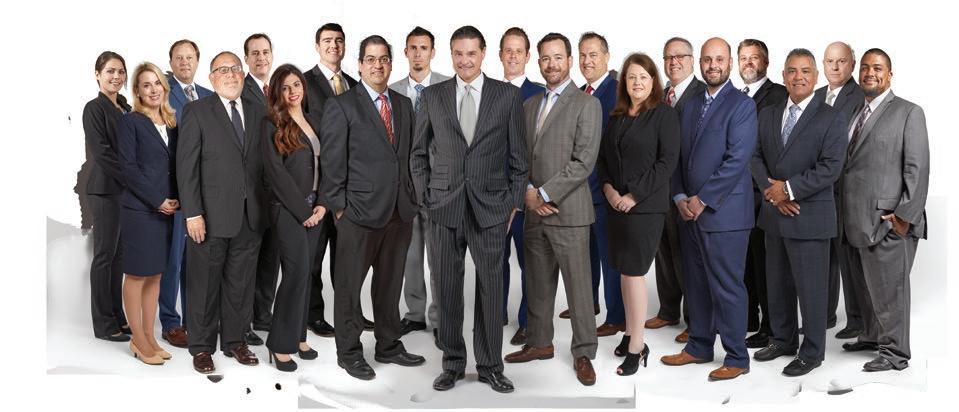
10 minute read
Three Important Steps to Change a Law Firm’s Organizational Culture
3 Important Steps to Change a Law Firm’s Organizational Culture
by James McCarthy
THE SOCIAL CONTRACT
Many law firms have developed over time what is called a “Social Contract.” In this contract, the organization “agrees” to provide such things as structure, meaningful work, policies and procedures, associate career tracks and training, compensation, and experienced partner-level oversight.
In return, staff provides time, effort, knowledge, skills, abilities, motivation, experience, etc.
Together, these things harmonize to make a firm productive, and to run more or less smoothly.
This Social Contract also helps form the basis for the Culture of an organization. As you will see shortly, culture consists of, or is reflected in part by the rules and regulations; agreements on how decisions are made; structures; symbols—such as mottos, dress codes, and space allocations—and perhaps most importantly, the underlying values and assumptions that guide everyday work and behavior.
Culture is an excellent “lens” through which to look at what is happening in any firm. It touches all levels and all areas of the business.
When a major change occurs, such as reorganization, a merger, or the introduction of a new strategic focus for the firm, that whole cultural foundation that has been built upon the unspoken agreements of the social contract can be shaken, severely damaged, or even destroyed.
In that scenario regular staff and perhaps even some Partners who knew more or less what their future would most likely be, now may not. They are not sure if their skills or background will be a match for the new requirements. They don’t necessarily know how to behave anymore. They may not even know how to do the work anymore, as such processes as billing arrangements and targets may change, schedules and assignments become unclear, seem to be arbitrary, or have simply disappeared. They do not have a clear sense of what is valued any longer. All this uncertainty helps them become frustrated and scared, and when people are scared, very dysfunctional things can happen.
Because employees are worried and unsure, resistance to the changes can occur. It may manifest as conflict between workers; conflict with management; an increase in sick time usage or accidents; work slowdowns may happen; quality and productivity may suffer, there will be unclear messaging; potentially vague lines of authority, and more.
Management is not exempt in any way from this process. Potentially, non-equity Partners, and perhaps some Full Partners may no longer be sure of how to do their jobs effectively; how to communicate; how to evaluate people; how to motivate; instruct, and develop subordinates—it may even be unclear how to strategize and set goals since a clear Strategic Future Picture may no longer exist.
So, what often happens is that the organization starts to “speak” louder at each other. For Leadership, Speaking can refer to the exercise of raw management power with little or no consultation, for example:
• New roles; new policies and procedures; new assignments; increases in billing requirements; reductions in hours, even firings
On the employee side, this can include:
• Direct insubordination; peer conflict; poor work quality; work slowdowns; absenteeism; declining output, and more.
Having a clear, well-articulated vision of the future substantially reduces the possibility that major change can significantly impact the future of your firm. Strategic planning offers several persuasive reasons for its use. Strategy:
• Forces a look into the future and therefore provides an opportunity to influence that future or assume a proactive posture.
• Provides better awareness of staffing, facility, and training needs.
• Helps define the overall mission of the organization and focuses on the objectives, key leverage points, and measures of progress.
• Provides a sense of direction and continuity.
• Increases awareness, involvement, and buy-in, and provides standards of accountability for people, programs, and allocated resources.
Firms have a stark choice; they can let the fear and uncertainty overwhelm them, with serious consequences for individuals and the business, or, they can act decisively, with a solid plan based on reliable data and connected to a well-articulated Strategic Plan.
The first step in changing or affecting your culture involves understanding the culture you have. Once you gain a deep understanding of your present culture, you can look at longterm business strategies and goals and decide to what extent (if any) your culture may need to change.
Just as structure and design may be viewed as the skeleton and muscles of the organization, culture can be seen as the firm's “heart”, or core. This culture consists of shared assumptions and values that shape partners', associates' and employees’ behaviors and help them understand the firm and their place within it. These assumptions and values are established over time by both formal and informal leaders. They are displayed and derived from such things as heroes, tales, and customs and present a powerful set of forces that are enduring, deep, and universally accepted. A strong culture is one in which attitudes and standards are widely shared and strongly held. Such a culture offers many advantages, including:
• Collaboration—Shared values enhance goodwill and mutual trust, encouraging teamwork.
• Decision Making—Shared beliefs and values lead to more efficient decision making, since there are fewer disagreements about which ideas should prevail.
• Influence—A strong culture serves to influence “right” actions.
• Exchange of ideas—Agreement on beliefs and values facilitates enhanced communication.
• Dedication—Strong cultures foster strong allegiance to the firm.
Successful culture change requires an integrated process involving not only modifications of cultural elements, but also may include corresponding steps involving leadership; communication; behaviors, and even structural changes. That is, successful culture change cannot occur in a vacuum.
There are several proven methods to help you in the first step of understanding your culture:
• Culture Audit—A "culture audit" can help assess the culture that currently exists in your firm. An effective firm culture audit describes the overall working environment; identifies the unwritten standards and rules governing all interactions and workplace practices; determines possible barriers to effective work routines and communication and may make recommendations for addressing identified problems.
• Organizational Character Indexing—Built upon the Myers-Briggs © personality types, a law firm's character can shape how decisions get made, new ideas are received, how people are treated, and whether change is accepted or rejected—all factors that affect firm performance.
• Culture Surveys—A law firm culture survey is a way to take the pulse of a firm's culture. A culture survey can be a powerful tool to better understand the shared values that underpin performance, as well as to identify culture-related areas for change.
• A newer and interesting method involves using both leader and organizational Preferences and Motiva
tions as “lenses” into cultural components—ultimately, people have to want to make the change, and you need to know how change is best received or implemented in your firm.
• Still other methods include: Observation; Interviews of colleagues and clients; Focus Groups, and Examination of mission and vision statements.
By gaining a clear understanding of your present culture, you will be able to make judgments regarding your desired culture and how to create it, based on both objective and subjective data.
The next step, actual culture change, typically begins at the top of the organization, either from your Managing Partner, or from his or her Leadership Team.
Changing Your Law Firm’s Culture
Culture change is particularly difficult because it often involves large-scale organizational change. In addition, the change is in things close to the “spirit”, or “heart” of the firm. Let’s examine some options for successful culture change:
• Leadership (typically the Senior Partner and his / her team) must develop a compelling Future Picture, a set of recommendations, and a convincing case for change. A clear destination becomes even more important during implementation of the recommendations. It can help keep everyone motivated and moving in the right direction. If Partners, Associates, and Staff do not understand the vision and plans for how the changes will help, as well as the consequences of inaction, they will be less open to the recommendations. Solid, coherent tactics derived from the Future Picture must be developed to move the recommendations forward.
• Keep a sense of urgency. In addition to the clear sense of direction provided by a shared Future Picture, employees also need to experience some level of urgency about changing the status quo. It is probably naive to think that all the leadership team’s recommendations will move forward on their own merits, so the plans must have plenty of support from all interested parties. Kotter (1995) believes that the sense of urgency is not high enough until 75 percent of a firm’s leaders (the critical mass) are convinced that “business as usual is totally unacceptable.”
• Focus undivided attention on the new culture. “Undivided attention” is usually a good thing. However, because the stakes are so high and the competition is so fierce, leaders are increasingly required to spread their attention across a number of areas: client generation and servicing; concurrent change initiatives; human and organizational aspects of those change initiatives; ongoing strategic planning, and the day-to-day business of the firm. Consequently, there must be continual focus on the new culture, through multiple channels, and a strong message sent that the journey is just beginning. • Value diversity and “subcultures” and honor the past. Diversity in the organization may be the key to successful culture change. Creating a new culture from scratch is difficult and may be seen as inconsistent with the norms and values of the firm. In addition, people may have invested themselves heavily in the past way of doing business. It often backfires when the past is criticized too strongly. Subcultures that already exist may embody desired characteristics and serve as “seeds” for change. Producing culture change is a bit like creating an infectious disease. You want a lot of people to “catch the bug” so they will spread it to other people. A bright focus must be kept on the recommendations and their implementation.
• Communication is the key. If colleagues do not understand the desired culture, why it is important, and what must change to create it, it is doubtful that change will happen. If an information vacuum is allowed to develop, people will fill it by creating their own information, whether or not it is accurate. Unfortunately, they often feed their worst fears and make up disaster scenarios. A little information about what is and is not known can go a long way to ameliorate the tendency to feed the rumor mill with anxiety-producing tales.
As the potential courses of action listed suggest, successful culture change requires a cohesive process involving not only changes in the culture, but also equivalent steps involving organizational elements such as leadership; communication; processes; policies, and perhaps even organizational form (structure) changes. Simply put, successful culture change cannot be done as a stand-alone project. It will almost certainly require several coordinated actions.
Culture change always seems to take longer than the time planned or desired. Culture change is not immediate, and it will without doubt meet with uncertainty, frustration, and even anger. A particularly vexing problem is that in the middle of most major changes, the problems are quite evident, but benefits are still in the future. The firm must be willing to commit to the time needed for full and successful culture change. n
James McCarthy joined Wolf Management Consultants, LLC as a very seasoned Organization Development (OD) and Executive Consultant. He has over 25 years line management and consulting experience with a multi-industry perspective. A Certified Professional Consultant, with five University Degrees, including Masters Degrees in Management, and in Organization Development, as well as eight professional certifications, Jim is recognized as an accomplished practitioner who has a complete grasp of the entire continuum of the Organization Development discipline—from planning through execution. Learn more at www.wolfmotivation.com.









